
Why India's latest Sun mission finding is crucial for the world
Scientists in India have reported the “first significant result” from Aditya-L1, the country’s first solar observation mission in space.
The new learnings, they said, could help keep power grids and communication satellites out of harm's way the next time solar activities threatened infrastructure on Earth and space.
On 16 July, the most important of the seven scientific instruments Aditya-L1 is carrying – Visible Emission Line Coronagraph, or Velc – captured data that helped scientists estimate the precise time a coronal mass ejection (CME) began.
Studying CMEs – massive fireballs that blow out of the Sun’s outermost corona layer – is one of the most important scientific objectives of India’s maiden solar mission.
“Made up of charged particles, a CME could weigh up to a trillion kilograms and can attain a speed of up to 3,000km [1,864 miles] per second while travelling. It can head out in any direction, including towards the Earth,” says Prof R Ramesh of the Indian Institute of Astrophysics that designed Velc.
“Now imagine this huge fireball hurtling towards Earth. At its top speed, it would take just about 15 hours to cover the 150 million km Earth-Sun distance.”

/cloudfront-us-east-2.images.arcpublishing.com/reuters/2ZJFJEPJQRKPPGAEOEZP4XYNZY.jpg)



















